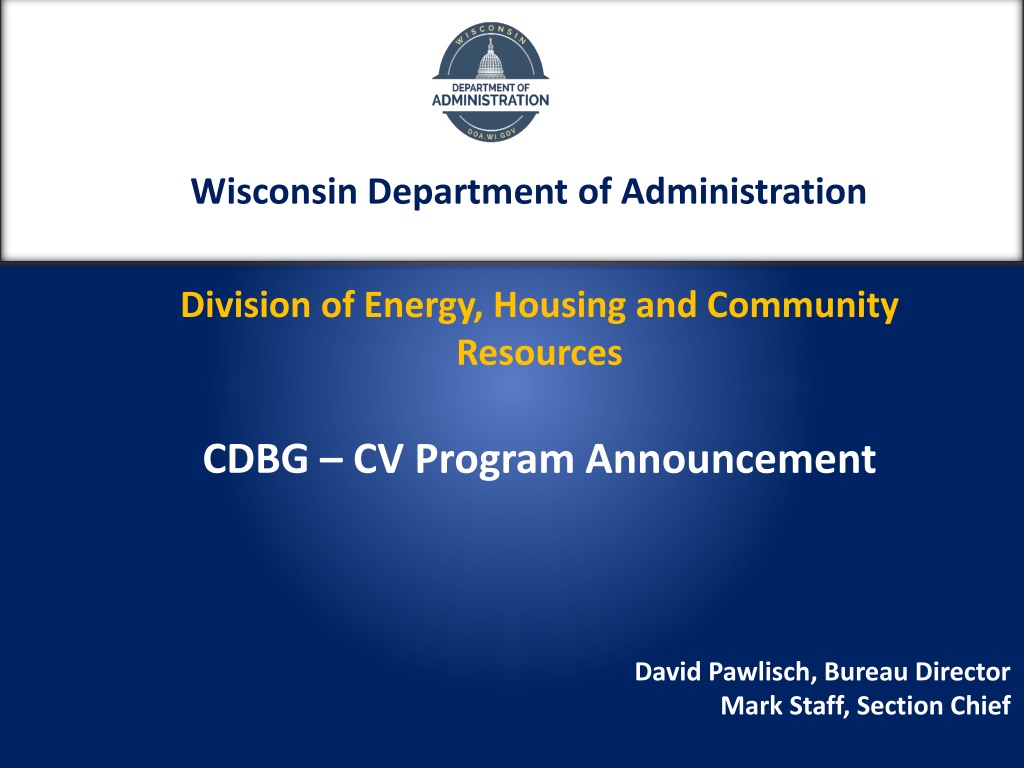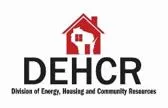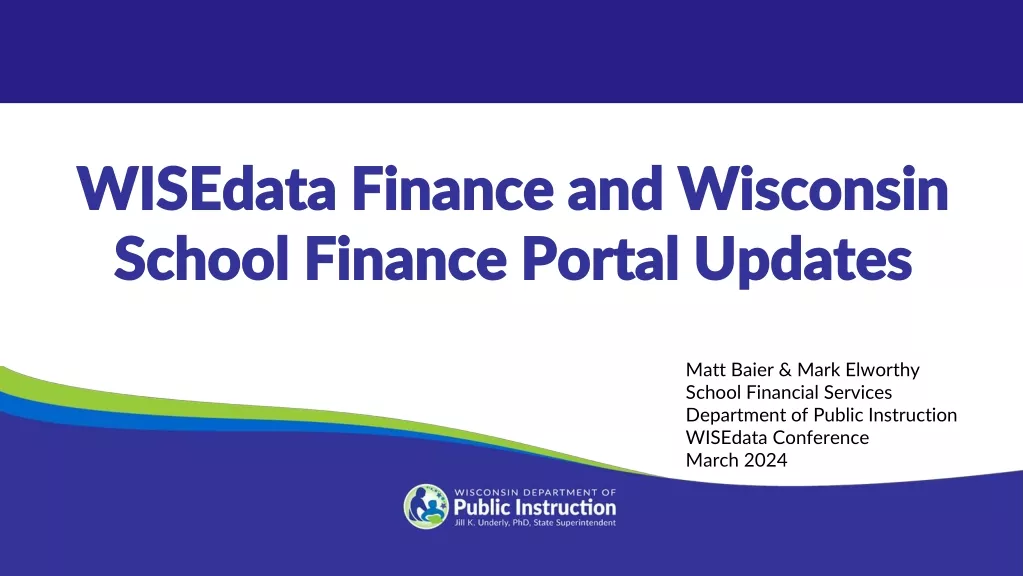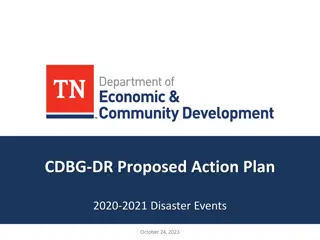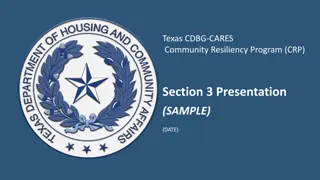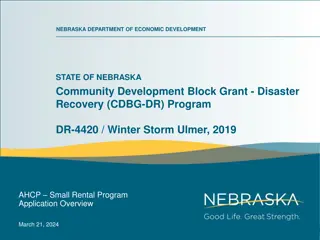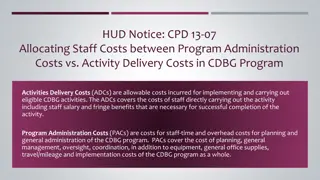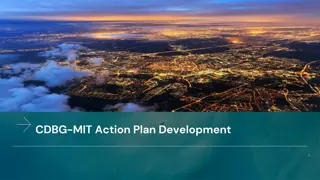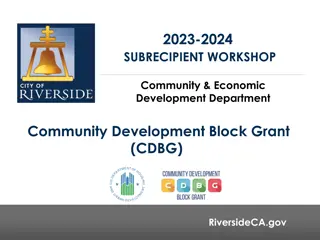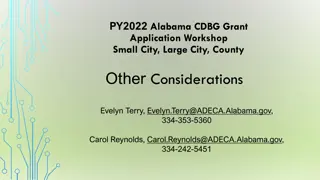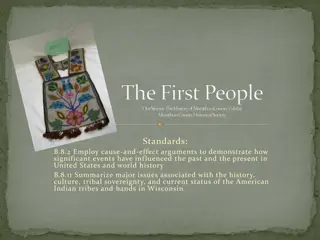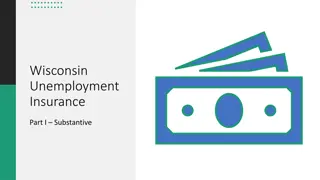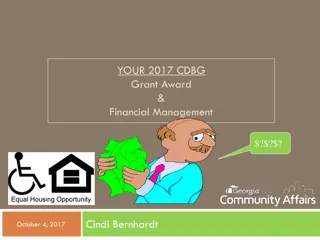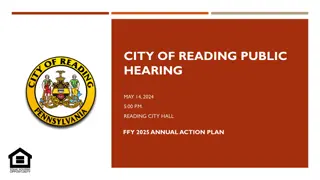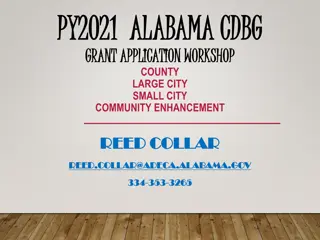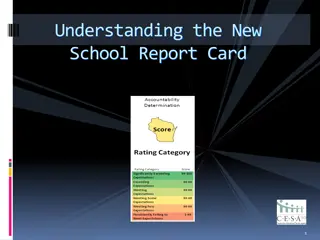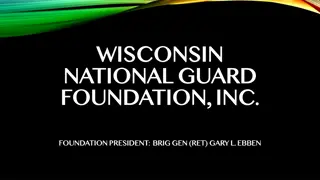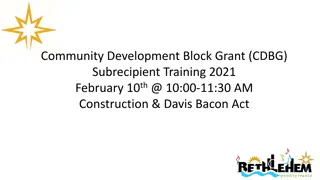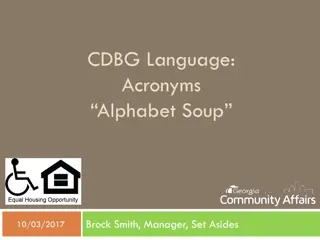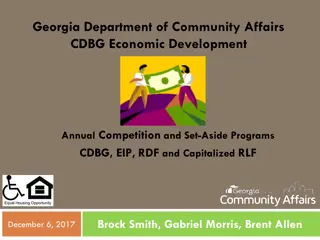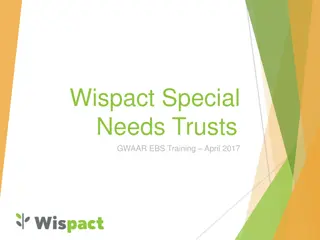Wisconsin Department of Administration CDBG-CV Program Details
The Wisconsin Department of Administration's Division of Energy, Housing, and Community Resources has released information on the CDBG-CV Program, detailing available funding rounds, distribution strategies, and eligible activities. Learn about how the program supports communities in the state.
Download Presentation

Please find below an Image/Link to download the presentation.
The content on the website is provided AS IS for your information and personal use only. It may not be sold, licensed, or shared on other websites without obtaining consent from the author. Download presentation by click this link. If you encounter any issues during the download, it is possible that the publisher has removed the file from their server.
E N D
Presentation Transcript
Wisconsin Department of Administration Division of Energy, Housing and Community Resources CDBG CV Program Announcement David Pawlisch, Bureau Director Mark Staff, Section Chief
Areas of Discussion Division Mission Community Development Block Grant (CDBG) COVID19 (CV) Program (CDBG-CV) Available Funding What can CDBG-CV be Used for? Application Process CDBG CV Details Questions
CDBG-CV Program The State submitted to HUD a Substantial Amendment to the State s Comprehensive Plan to create the CDBG CV Program (CDBG-CV) which HUD has approved. Division of Energy, Housing and Community Resources(DEHCR) developed and obtained approval of a method of distribution of CDBG CV funds. On 8/20/20, HUD published the Federal Register containing program rules, waivers and regulations as well as program guidance on eligible activities and national objective compliance.
Available Funding Round One CDBG CV funding awarded to the State of Wisconsin totals $16,107,955 and will be distributed to non-entitlement units of general local government. Round Two CDBG CV funding awarded to the State of Wisconsin totals $16,970,300. This funding will be made available to entitlement and non-entitlement units of government. 57% of this total will be distributed to entitlements while the remaining 43% will be added to the round one CV funding and be made available to non-entitlement communities. Round Three CDBG CV funding awarded to the State of Wisconsin totals $10,919,141. These funds will be made available in non-entitlement areas of the State. DOA is determining if these funds will be added to CV1 and CV2 or used to create a renter or homeowner assistance fund.
Available Funding Non-entitlement funding will be distributed within Regions based on non-entitlement population within the regions. CDBG Housing Regions are used as the regions. Applications within each region will compete against the other applications generated from within their region. If a region lacks enough applications to utilize all the funds within a region, the remaining funds will be transferred to meet the needs of other regions. Entitlement communities will be awarded a set amount of funds based on the percentage of funding the entitlements and State Small Cities program received in Round One.
CDBG HOUSING REGIONS Bayfield Iron Douglas Ashland Vilas Washburn Burnett Sawyer Florence Oneida Price Forest Polk Rusk Marinette Barron Lincoln Langlade Taylor Chippewa St. Croix Menominee Marathon Dunn Oconto Shawano Clark Pierce Door Kewaunee Eau Claire Pepin Waupaca Wood Portage Brown Buffalo Trempealeau Outagamie Jackson Winnebago Waushara Adams Calumet Manitowoc Monroe Marquette La Crosse Juneau Northwest Housing Region Green Lake Fond du Lac Sheboygan Vernon Northwoods Housing Region Dodge Columbia Washington Sauk Richland Ozaukee West Central Housing Region Crawford Jefferson Dane Milwaukee Waukesha Grant Iowa Central Housing Region Racine Walworth Rock Green Lafayette Northeastern Housing Region Kenosha Southwest Housing Region Southern Housing Region Entitlement Counties
Available Funding CV1 and CV2 Only Northwest Region $1,077,501 Northwoods Region $1,449,662 West Central Region $2,923,723 Central Region $2,819,671 Northeast Region $4,866,697 Southwest Region $2,512,108 Southern Region $6,121,055
How to Use CDBG-CV Funds Any proposed use of CDBG CV funds must prepare for, prevent, or respond to coronavirus. All proposed programs and projects must directly prepare for, prevent, or respond to coronavirus. All proposed programs and projects must meet a CDBG National Objective, being, Low to Moderate Income (LMI) Benefit or Urgent Local Need (ULN).
Example Projects/Programs Example Project/Program Types: Renter Assistance/Emergency Payments for up to six months. Business Assistance Grants Micro-Enterprise Business Assistance Grants Food Bank/Pantry, expansion, restocking, establishment PPE Purchases Transitional Housing Childcare/Daycare Centers Homeless Shelters Senior Centers Drug Abuse Programs Isolation Centers Temporary Housing Provide in-home services such as meal/grocery delivery, medicine, to quarantined individuals Assistance to communities to address LMI student needs to access online classes
CDBG CV Intent to Apply (ITA) Applicant Information UGLG Name, Address, Contact Person Name, Email and Phone Number, Region Project Area/National Objective describe geographic service area, number of people to be assisted, National Objective and how you will meet it.
CDBG CV Intent to Apply (ITA) cont. Proposed Activity describe funded activity and how it prevents, prepares for or responds to coronavirus. Identify who will administer project/program. Status of partnerships to deliver program. Budget No match required. If match is needed is it secured? How will you protect against duplication of benefits? Timeline to Implement
Application Process How will this work? UGLG s wishing to apply must complete and submit an Intent to Apply Form (ITA). ITA s will identify the applicant, proposed use of funds, readiness to implement, and delivery strategy for the project or program. DEHCR will score each ITA and rank them against ITA s submitted from the Region within which they reside. ITA s will be scored using these criteria; Delivery Strategy of Program(30pts possible) Are Partnerships in place to deliver program or complete project Regional collaboration encouraged, county or regional level Larger projects with positive impact Readiness to Implement(25pts. possible) Do programs exist, activities possibly complete, well detailed Distress Factors (45pts. Possible) Unemployment Rate, COVID cases within the county, county median household income Applicants will be ranked against other applications within their respective Region.
CDBG-CV Program How will this work? DEHCR will invite final applications to be submitted from the highest ranking applicants from each Region until funds are exhausted for each region. UGLG s receiving awards will enter into a grant agreement with DOA and initiate their program/project. Performance period to complete programs/projects will be two years from application approval.
CDBG-CV Program Application Timeline October 7, 2020 Webinar Announcing CDBG CV Program. Intent to Apply Form made available on the DEHCR webpage. November 20, 2020 Intent to Apply Forms due to DEHCR December 18, 2020 DEHCR issues invitation to submit final CDBG CV Applications. February 26, 2021 CDBG CV application due to DEHCR. March 26, 2021 DEHCR announces awards and begins grant agreement development.
CDBG-CV Details Final CDBG CV application has the same federal strings as the public facilities and housing programs. Grants over $150,000 require quarterly reporting. No Public Services Cap. LMI Job Creation Criteria position wage rate compared to one person household income. No employee certifications required.
CDBG-CV Details Abbreviated Environmental Review for most projects/programs. Duplication of Benefits, very important for business assistance, rental assistance, other public service programs. Shortened Public Hearing Notification period 5 days. Cannot supplant or replace municipal expenditures.
Contacts Mark Staff, Section Chief, mark.staff@wisconsin.gov or 608-635-6058 David Pawlisch, Bureau Director, david.pawlisch@wisconsin.gov or 608-333- 8047
